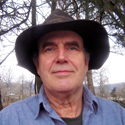Trail Talk – October 2019
To live in a town with such a storied past should have one always looking and asking, “I wonder what that old wall is from?” or “Where did that old path lead?” or “Where did this old water ditch come from?” We find ourselves in Jacksonville’s extensive public woodlands asking those very questions. Aldo Leopold, in Sand County Almanac, writes of moving into a reclaimed woodland area, and marvels at “Nature reasserting Herself where Man’s presence has been absent for some time.” We are of the same mind as we explore Jacksonville’s trails.
The Woodlands of Britt Ridge hold much evidence of the miners’ presence in water ditches, (particularly the Petard Ditch) hydraulic mining sites, and “diggings.” What tunneling was done there is mostly obliterated over time, but remnant collapses are still visible. Old fence lines have been removed, but evidence of a century of cattle grazing remains. The old waterline from the historic reservoir has become the popular Zigler Trail.
Across the highway, in Forest Park, other evidence of human activity has emerged as trails are re-established along old byways. Arrow points recovered near appropriately named Arrowhead Pass and an old pestle along Pipsissewa Tr. tell of the First Nations occupying the watershed and carrying on their daily activities. We can only imagine how the landscape has changed over the millennia since they first arrived.
In each of the canyons of Forest Park, old roadbeds are evident. These were certainly wagon roads at one time, and Rail Tr. follows a good length of the old Bullis Railroad. How far the actual rails extended at one time up toward the old mill site above Cantrall Creek is a question for historians, but the evidence is literally etched in the granitic bed-rock of Cantrall Creek Trail.
The old ditches that supplied water for the hydraulic mining area on Ol’ Miners’ Tr. can be traced back into Norling Gulch on Ol’ Miners’, Boulder, and Owl Hoot Trails. Another large ditch is evident in the China Ditch section of Arrowhead Pass Tr. as well as a section of Claimjumper Trail. Along Canyon Falls, Cantrall Creek, Shade Creek, and Atsahu Trails, one finds remnant dams- some used to enhance Jacksonville’s municipal water supply and others to divert water for mining. On Knobcone Pine, Rattlesnake Gulch, and Pipsissewa Trails, old ‘diggins’ and remnant barrel hoops speak to other mining activity.
Many of the trails in Forest Park have reclaimed sections of logging roads. Old photographs show that logging has occurred since the first settlers arrived, and as the forest regenerated itself and was re-harvested, these old roads were put to use again. Atsahu, Twin Peaks, Jackson Ridge, Jackson Creek, Legburner, Claimjumper, and Sofie’s Trails follow many of these old roads and spurs.
During the 60s and 70s, many of these old byways were ‘discovered’ and used by motorcycle riders. When Forest Park became a reality, the riders moved to the MRA property, and many of the trails became hiking and biking thoroughfares. Trails don’t simply show up for no reason. Ask yourself as you hike along, “Why is there a trail here? What is the history of this area?”
 Trail Talk is a monthly column by Clayton Gillette about hiking the Jacksonville Woodlands trail system. For more information, please visit the Jacksonville Woodlands Association website at
Trail Talk is a monthly column by Clayton Gillette about hiking the Jacksonville Woodlands trail system. For more information, please visit the Jacksonville Woodlands Association website at